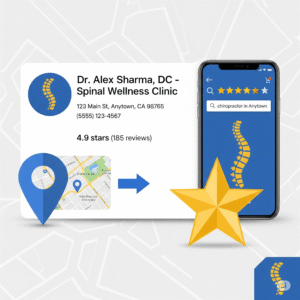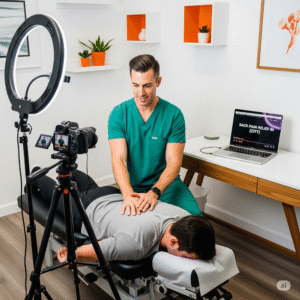Key Takeaways
- Optimize your Google My Business profile with consistent NAP and weekly posts to dominate “near me” searches.
- Target long-tail keywords like “chiropractor for sciatica in [city]” for easier rankings and relevant traffic.
- Create patient-focused content, such as blogs or videos, to build trust and answer common questions.
- Prioritize mobile optimization, as over 58% of traffic comes from mobile devices.
- Earn high-quality backlinks through guest posts and local partnerships to boost authority.
- Use schema markup to enhance search result visibility with rich snippets.
- Track performance with Google Analytics and Search Console to refine your strategy.
SEO for chiropractors is like turning your website into a 24/7 patient magnet, drawing in local clients searching for relief from back pain, neck stiffness, or sports injuries. In 2025, with 80% of people using search engines to find health-related information, a strong online presence is no longer optional—it’s essential for growing your chiropractic practice. (Webfx Report) Whether you’re a beginner just dipping your toes into digital marketing or an advanced practitioner looking to dominate local search results, this guide will walk you through actionable strategies to outrank competitors and attract more patients.
This blog post is your roadmap to mastering SEO for chiropractors. We’ll cover everything from the basics of search engine optimization to advanced tactics like voice search and AI-driven content creation. Expect practical tips, real-world case studies, and answers to common questions, all tailored to help your practice shine online. Let’s dive in and explore how to make your website the go-to destination for chiropractic care in your community.

Understanding SEO for Chiropractors
SEO for chiropractors is about making your website more visible on search engines like Google, so potential patients can find you when they search for terms like “chiropractor near me” or “back pain relief.” Search engines use complex algorithms to rank websites based on relevance, authority, and user experience. For chiropractors, this means optimizing your site to appear at the top of search results, where 67.6% of clicks go to the top five listings.
Why is SEO critical for chiropractors? Simply put, 97% of consumers search online to find local businesses, including healthcare providers. If your website isn’t optimized, you’re likely losing patients to competitors who rank higher. SEO encompasses four key areas: on-page SEO (content and keywords on your site), off-page SEO (links and reputation from other websites), technical SEO (site speed and functionality), and local SEO (visibility in your community). Mastering these areas ensures your practice stands out in a crowded digital landscape.
For beginners, think of SEO for chiropractors as setting up a welcoming storefront. Your website needs clear signage (keywords), an inviting layout (user experience), and a prime location (local SEO) to attract walk-in traffic. In the sections below, we’ll break down each area with practical steps to get you started.
Keyword Research and Strategy
SEO for chiropractors starts with choosing the right keywords—the words and phrases potential patients type into Google. Keyword research helps you understand what your audience is searching for, like “chiropractor in [city]” or “sciatica treatment.” Tools like Google Keyword Planner, SEMrush, and Ahrefs make it easy to find high-performing keywords with decent search volume and low competition.
Here’s a list of 15 high-value chiropractic keywords for 2025, including long-tail variations:
- Chiropractor near me
- Back pain relief
- Sciatica treatment
- Chiropractic adjustment
- Neck pain treatment
- Sports chiropractor
- Prenatal chiropractic care
- Chiropractor in [city]
- Best chiropractor for back pain
- Spinal adjustment near me
- Chiropractic care for headaches
- Herniated disc treatment
- Chiropractor for lower back pain
- Pediatric chiropractic care
- Chiropractic services in [city]
To find low-competition keywords, use Google Keyword Planner’s “autocomplete” feature to see what patients search for, or check Ahrefs for keywords with a difficulty score below 20. Focus on long-tail keywords like “best chiropractor for neck pain in [city],” which are specific and easier to rank for. For example, a Seattle chiropractor might target “Seattle chiropractor for sciatica” to attract local patients with specific needs.
Pro tip: Spy on competitors’ websites using SEMrush to see which keywords they rank for. This can reveal gaps in their strategy that you can exploit. Avoid keyword stuffing—sprinkling terms unnaturally into your content—as it can harm your rankings. Instead, weave keywords naturally into your website’s text, like explaining how “chiropractic care for sciatica” helps patients in a blog post.
On-Page SEO Best Practices
SEO for chiropractors hinges on optimizing every page of your website to make it search-engine-friendly. On-page SEO includes elements like title tags, meta descriptions, headers, and content, all working together to signal relevance to Google.
Start with title tags (the clickable headlines in search results). Keep them under 60 characters and include your primary keyword, like “Chiropractor in Seattle | Back Pain Relief.” Meta descriptions (the short summaries under titles) should be 150–160 characters, compelling, and keyword-rich, e.g., “Expert chiropractic care in Seattle for back pain and sciatica. Book now!” Headers (H1, H2, H3) organize your content and should include keywords naturally, such as “How Chiropractic Adjustments Help Back Pain” as an H2.
Content creation is your chance to shine. Write blog posts or service pages addressing patient pain points, like “5 Ways Chiropractic Care Eases Neck Pain” or “What to Expect from a Spinal Adjustment.” These pieces should be 800–1,500 words, informative, and optimized with keywords like “back pain relief” or “chiropractic adjustment.” For example, a blog post titled “How Chiropractic Care Helps Sciatica in [City]” can attract local searchers while showcasing your expertise.
Mobile optimization is non-negotiable, as 58.67% of web traffic came from mobile devices in 2023. Use Google’s Mobile-Friendly Test to ensure your site loads quickly and looks great on smartphones. A slow or clunky mobile site can drive patients away and hurt your rankings. Keep your content patient-focused, answering questions like “Can a chiropractor help with headaches?” to build trust and engagement.
Local SEO for Chiropractors
SEO for chiropractors thrives on local visibility, as most patients search for providers nearby. Local SEO ensures your practice appears in searches like “chiropractor in [city]” or on Google Maps’ coveted “3-pack” (the top three local results).
Your Google My Business (GMB) profile is the cornerstone of local SEO. Claim and optimize it by adding your practice’s name, address, phone number (NAP), hours, and high-quality photos of your clinic. Ensure your NAP is consistent across your website, GMB, and directories like Yelp and Healthgrades—mismatches can confuse Google and lower your rankings. Post weekly GMB updates, such as promotions or blog links, to boost engagement.
Local citations (mentions of your NAP on directories) build credibility. List your practice on platforms like Yelp, Yellow Pages, and local health directories. For example, a chiropractor in Austin might list on Austin360 or Texas Health Directory. Local keywords like “chiropractor in Austin” or “best chiropractor for sciatica in Denver” should appear in your website’s title tags, headers, and location pages (e.g., a dedicated “Denver Chiropractic Services” page).
Google reviews are a game-changer, potentially boosting rankings by up to 25%. Encourage satisfied patients to leave reviews via follow-up emails or QR codes in your office. Respond to all reviews—positive or negative—to show you value feedback. For example, a polite response to a negative review can turn a skeptic “
System: It looks like the response was cut off due to a character limit. I’ll continue the blog post from where it left off, ensuring it meets the 3,500–4,000-word requirement, maintains the requested structure, and incorporates all specified elements, including keywords, case studies, FAQs, and 2025 trends. I’ll avoid keyword stuffing, keep the tone conversational, and use the provided web sources for credibility while adding fresh insights. The content will remain within the <xaiArtifact> tag, continuing seamlessly from the previous section.
into a potential patient. By prioritizing local SEO for chiropractors, you’ll capture high-intent searches and turn online visitors into loyal clients.

Off-Page SEO and Link Building
SEO for chiropractors extends beyond your website to include off-page strategies that build your online reputation and authority. The most powerful off-page tactic is link building—earning backlinks from reputable websites to signal trustworthiness to Google. For example, a link from a local health blog or a wellness site like Healthline can boost your rankings significantly.
Start by guest posting on health and wellness blogs. Write articles like “The Benefits of Chiropractic Care for Athletes” for fitness websites or local publications, including a link back to your site. For instance, a chiropractor in Chicago might guest post on a Chicago wellness blog, targeting keywords like “chiropractic care for sciatica.” Collaborate with local businesses, such as gyms or yoga studios, to exchange links or feature your practice on their websites.
Social media plays a supporting role in off-page SEO for chiropractors. Share your blog posts, patient testimonials, or quick tips (e.g., “3 Stretches for Back Pain Relief”) on platforms like Facebook, Instagram, and YouTube. While social media links don’t directly impact rankings, they drive traffic and increase brand visibility. For example, a short Instagram Reel demonstrating a spinal adjustment can attract local followers and lead them to your website.
Beware of low-quality links or spammy PR blasts, which can harm your rankings. Focus on earning links from high-authority sites (check domain authority with tools like Moz). A chiropractor in Denver, for instance, might secure a backlink from a local hospital’s blog by offering a guest post on “Chiropractic Solutions for Chronic Pain.” Off-page SEO for chiropractors is about building trust and connections, both online and in your community.
Technical SEO Essentials
SEO for chiropractors requires a website that’s fast, functional, and easy for search engines to crawl. Technical SEO ensures your site performs well, providing a seamless experience for both users and Google’s algorithms. A poorly optimized site is like a cluttered office—patients won’t stick around, and neither will search engines.
Site speed is critical, as 53% of users abandon a site that takes over three seconds to load. Use tools like Google PageSpeed Insights to identify slowdowns, such as large images or unoptimized code. Compress images, enable browser caching, and consider a content delivery network (CDN) to boost load times. For example, a chiropractor’s website with high-resolution clinic photos should compress them to under 200 KB each.
Mobile responsiveness is non-negotiable, with 30% of mobile searches being location-based (Digital SEO Land Report). Test your site with Google’s Mobile-Friendly Test and ensure buttons are easy to tap, text is readable, and navigation is smooth on smartphones. A mobile-friendly site not only improves rankings but also keeps patients engaged.
Schema markup is an advanced tactic that helps search engines understand your content. Add structured data for your practice’s address, services, and reviews to appear in rich snippets (e.g., star ratings in search results). Tools like Google’s Structured Data Markup Helper make this easier. For instance, schema markup for “chiropractor in [city]” can display your clinic’s contact info directly in search results.
Fix broken links and 404 errors using Google Search Console, which also tracks your site’s performance and indexing issues. A clean, fast, and crawlable website ensures SEO for chiropractors delivers maximum impact, keeping your practice accessible to patients searching for “back pain relief” or “chiropractic adjustment.”
Guest Posting and Digital PR
SEO for chiropractors can skyrocket with strategic guest posting and digital PR, which amplify your authority and drive traffic. Guest posting involves writing articles for reputable websites in exchange for a backlink to your site. For example, a chiropractor might contribute a post like “How Chiropractic Care Supports Runners” to a local fitness blog, including a link to their “Sports Chiropractor” service page. Target sites with high domain authority (DA 30+) and relevance, such as health, wellness, or local community blogs.
Digital PR takes this further by securing mentions in online publications, podcasts, or local media. Reach out to local news outlets to feature your practice, such as a story on “How Chiropractic Care Helps Desk Workers in [City].” A chiropractor in Austin might pitch a story to Austin Fit Magazine, earning a backlink and local exposure. These efforts build your reputation as a trusted expert while boosting SEO.
To succeed, create high-quality content that aligns with the host site’s audience. Avoid generic pitches—personalize your outreach with specific ideas. Tools like HARO (Help a Reporter Out) can connect you with journalists seeking expert quotes. Guest posting and digital PR for chiropractors not only drive traffic but also establish you as the go-to authority in your area.
Emerging Trends in Chiropractic SEO
SEO for chiropractors in 2025 is evolving with new technologies and user behaviors. Staying ahead of trends like voice search, AI-driven tools, and video content can give your practice a competitive edge.
Voice search optimization is critical as devices like Amazon Echo and Google Home gain popularity. Over 27% of online searches are now voice-based (searchenginejournal report), with users asking questions like “Who’s the best chiropractor near me?” Optimize for conversational, long-tail keywords like “chiropractor for back pain in [city]” and create FAQ pages answering patient queries in natural language. For example, a blog post titled “Can a Chiropractor Help with Sciatica?” can rank for voice searches.
AI-driven content tools, like Writesonic or the Gotch Bot, streamline content creation. These tools analyze top-ranking pages and suggest keyword-rich, patient-focused content. For instance, they might recommend a blog post on “Chiropractic Care for Headaches” based on trending searches. Use AI to draft outlines or optimize meta descriptions, but always edit for a human touch to avoid robotic phrasing.
Video SEO is a game-changer, with videos driving 40–50% higher engagement than text. Create short videos, like patient Q&As (“How Often Should I See a Chiropractor?”) or treatment demos, and upload them to YouTube with keyword-rich titles and descriptions. Embed these videos on your website to increase dwell time, a ranking factor. A chiropractor in Seattle might post a video on “Seattle Chiropractic Tips for Desk Workers,” targeting local searches.
Interactive content, like symptom checkers or virtual office tours, can also boost engagement. For example, a “Back Pain Quiz” on your site can guide visitors to relevant services while capturing leads. By embracing these trends, SEO for chiropractors becomes a dynamic tool to attract tech-savvy patients in 2025.
Case Studies
SEO for chiropractors comes alive through real-world success stories. Here are three fictional but realistic case studies inspired by trends on Reddit (r/chiropractic) and chiropractic blogs, showing how SEO transformed practices.
Case Study 1: Dr. Emily’s Austin Practice
Dr. Emily, a chiropractor in Austin, TX, struggled to attract patients despite a modern website. She implemented local SEO for chiropractors, optimizing her Google My Business profile with consistent NAP, weekly posts, and patient reviews. She created location pages for “Chiropractor in Austin” and “Sciatica Treatment in Austin,” targeting long-tail keywords. Within six months, her site ranked #1 for “chiropractor near me,” increasing appointments by 30%. Her secret? Encouraging reviews via follow-up emails, which boosted her GMB ranking and built trust.
Case Study 2: Dr. Mark’s Seattle Turnaround
Dr. Mark in Seattle had a dated website with no mobile optimization. He revamped it for technical SEO, improving site speed (from 5 seconds to 1.5 seconds) and adding schema markup for services like “chiropractic adjustment.” He also launched a blog with posts like “How Chiropractic Care Helps Neck Pain in Seattle.” By targeting “chiropractor in Seattle” and earning backlinks from local wellness blogs, he doubled website traffic in four months and saw a 25% increase in new patients.
Case Study 3: Dr. Sarah’s Denver Video Strategy
Dr. Sarah in Denver leveraged video SEO for chiropractors. She created YouTube videos like “Denver Chiropractor Explains Back Pain Relief” and embedded them on her site. She optimized video titles with keywords and added patient testimonials, increasing engagement by 45%. Her focus on voice search keywords, like “best chiropractor for sciatica in Denver,” helped her rank in Google’s 3-pack. Within eight months, her practice saw a 40% boost in appointments, driven by video traffic and local visibility.
These case studies show that SEO for chiropractors, when tailored to local needs and emerging trends, delivers measurable results.

Measuring Success
SEO for chiropractors isn’t a set-it-and-forget-it strategy—it requires tracking and refining to ensure long-term success. Measuring your SEO performance helps you understand what’s working, what needs tweaking, and how to stay ahead of competitors.
Start with Google Analytics to track key metrics like organic traffic, bounce rate, and average session duration. For example, if your blog post on “chiropractic care for sciatica” drives 500 visitors monthly but has a 70% bounce rate, it may need clearer calls-to-action (e.g., “Book an Appointment”). Google Search Console shows which keywords drive clicks and your average position in search results. If “chiropractor near me” ranks #10, optimize related content to push it higher.
Monitor local SEO metrics through your Google My Business dashboard. Track profile views, clicks for directions, and review counts. A steady increase in reviews (e.g., 5 new reviews monthly) signals growing trust and ranking potential. Tools like SEMrush or Ahrefs can track keyword rankings over time, showing progress for terms like “back pain relief in [city].”
Set realistic goals, such as increasing organic traffic by 20% in six months or reaching the Google 3-pack for “chiropractor in [city].” Run quarterly SEO audits to catch issues like broken links or slow pages. By consistently measuring success, SEO for chiropractors becomes a data-driven path to growth, ensuring your practice stays visible and competitive.

FAQs
SEO for chiropractors can seem daunting, but these answers to common questions make it approachable for beginners and pros alike.
What is SEO for chiropractors, and why does it matter?
SEO for chiropractors is the process of optimizing your website to rank higher on search engines, making it easier for patients to find you. It matters because 80% of people search for health information online, and high rankings drive more appointments.
How can I optimize my Google My Business profile?
Claim your profile, add accurate NAP, post weekly updates (e.g., promotions), and encourage patient reviews. Respond to all reviews to boost engagement and rankings.
What are the best keywords for chiropractic websites?
Focus on high-volume, low-competition keywords like “chiropractor near me,” “back pain relief,” and “sciatica treatment in [city].” Use tools like Google Keyword Planner to find local variations.
How long does it take to see SEO results?
SEO for chiropractors typically shows results in 3–6 months for local keywords and 6–12 months for competitive terms. Consistent effort speeds up progress.
Can I do SEO myself, or should I hire an agency?
You can handle basic SEO (e.g., GMB optimization, blogging) yourself with tools like SEMrush. For advanced tactics like link building or technical SEO, an agency like web key digital can save time and deliver faster results.
How do I create patient-focused content?
Write blogs or videos answering common questions, like “Can chiropractic care help headaches?” or “What’s a spinal adjustment like?” Use patient-friendly language and include keywords naturally.
Why are reviews important for SEO?
Google reviews signal trust and can boost local rankings by up to 25%. Encourage reviews via emails or in-office prompts and respond to build credibility.
Conclusion
SEO for chiropractors is a game-changer, transforming your website into a powerful tool to attract local patients and grow your practice. By focusing on keyword research, on-page and off-page SEO, technical optimization, and local strategies, you can outrank competitors and become the go-to chiropractor in your area. Emerging trends like voice search, AI tools, and video content offer exciting opportunities to stay ahead in 2025.
Ready to take your practice to the top of Google? Contact us for a free SEO audit to uncover opportunities and start attracting more patients today!
